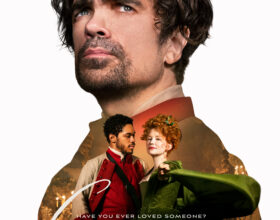This remarkable movie about the life of Christ is played reverently and features many teachings and incidents from the gospels. Nelson Leigh gives us a sincere and reverent Christ, and is very good in the role. He also has a distinguished voice, which works well since he does a lot of teaching in the film.
The movie opens with Peter, in prison, being told by a Roman guard that he will be executed. “Good-bye my dear friend,” the guard says to Peter. “I grieve for you.” “Grieve not,” replies Peter. Two visiting Jews are told the story of the life of Christ as Peter shares many details with them. He begins by speaking of the Nativity, the birth of Jesus in Bethlehem.
As Peter speaks the movie moves into various incidents as recorded in the gospels. He speaks of Christ as a Child Who even then was wiser than His years. This simple carpenter’s Son, raised by Joseph and Mary, was to change the world. John the Baptist, the one who went before Christ, proclaiming the kingdom of heaven was at hand, is arrested for speaking out against King Herod, who has taken his brother Phillip’s wife. It was John who preached about the coming Messiah, and that he was to “prepare the way of the Lord.”
The costumes and settings help lend a credence and reality to the film, although a few of the sets are very basic when compared to today’s world of marvelous sets and computer-generated images. The core of the movie is the teaching of Jesus, and in this film He is seen giving the beatitudes and the sermon on the mount to His listeners and followers. Yet there are moments of drama nicely portrayed, including the story of the woman at the well from John chapter four. Jesus stops at Jacob’s well during the heat of the day for a drink. When He engages in a conversation about the coming Messiah, He tells her He could have given her living water. She responds that when the Messiah comes, He will tell them all that they need to know. He tells her that He that is speaking to her is, indeed, the Messiah.
Another nice scene features Jesus giving the Lord’s prayer to His followers. Soon, He is seen not teaching but in action again, as He calls Lazarus from the dead, and Lazarus is reunited with his sisters Mary and Martha.
The movie doesn’t seem to be in exact chronological order, but the scenes are nicely done, and they move toward his eventual prayer in the Garden of Gethsemene, and Jesus’ destination with the cross to redeem mankind from sin. The movie features the scene with the woman at the well from John chapter 4, but then goes back to John 3 to share the story of Nicodemus and his discussion with Christ about being “born again.”
In a scene near the conclusion of the film, we see Jesus take a whip to the moneychangers, who are more interested in making a profit from the people than helping them spiritually. He also gets to the root of the problem with the rich young ruler, recognizing his love of his wealth and possessions. When Jesus tells him to give what he has to the poor and to follow him, he leaves Jesus.
In a dramatic scene in the film, Jesus shares the Last Supper with His disciples and it is posed exactly like da Vinci’s painting, which is considered a classic painting of Jesus at the Last Supper.
Next, we see Judas Iscariot’s betrayal of Jesus, and we see stripes on Christ’s upper body from being whipped. Pontius Pilate allows the people to choose between Jesus and Barabbas, an insurrectionist, and they choose Barabbas to be set free, and Jesus to be condemned. It is obvious from a previous scene that the religious leaders are envious of Jesus and the witnesses can’t even agree what he was supposed to have done wrong.
Jesus is sent to Calvary to be crucified and we see Simon of Cyrene carry his cross when Christ falls under the weight of it. In an interesting dramatic portrayal, we hear Jesus’ voice on the cross, but we do not see his face. A close-up of the two thieves he was crucified with are shown, and the scene in which one repents of his sins, and Jesus tells him that this day he would be in paradise. We hear Jesus give the care of His mother to His disciple John, and we hear Him say He is thirsty as well as, “My God, my God, why hast thou forsaken me?” And, at the end, “It is finished. Father, into thy hands I commend my spirit.”
Later, happily, His resurrection is seen as He appears to both Mary Magdalene and His disciples. The hope of the resurrection is nicely portrayed. This wholesome telling of the story of Christ is nicely handled, and the violence is pretty tame compared to today’s films. The teachings of Jesus permeate the film and it has earned our Dove seal for All Ages.
The Dove Take
Your entire family will enjoy watching this remarkable film together, as the life of Christ is played reverently and is vividly brought to life.





